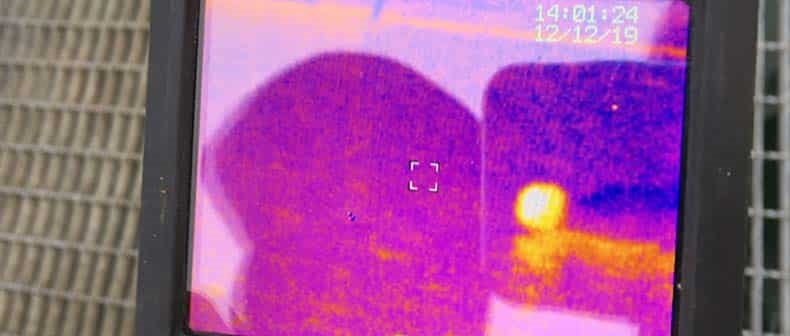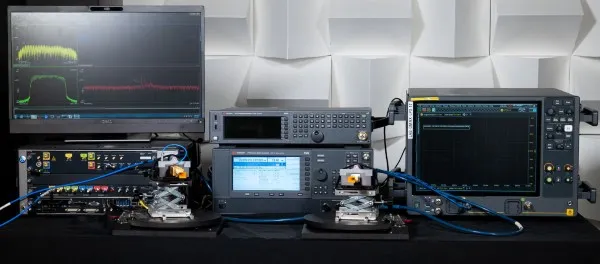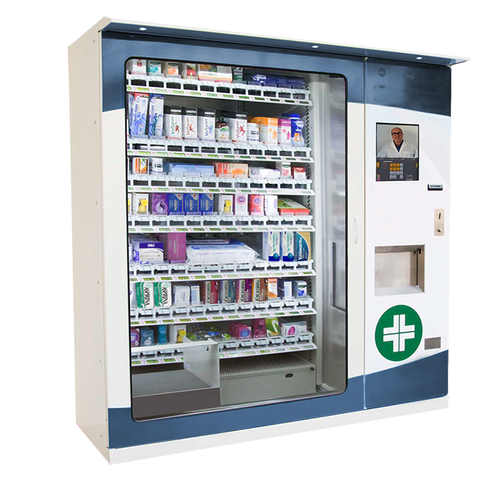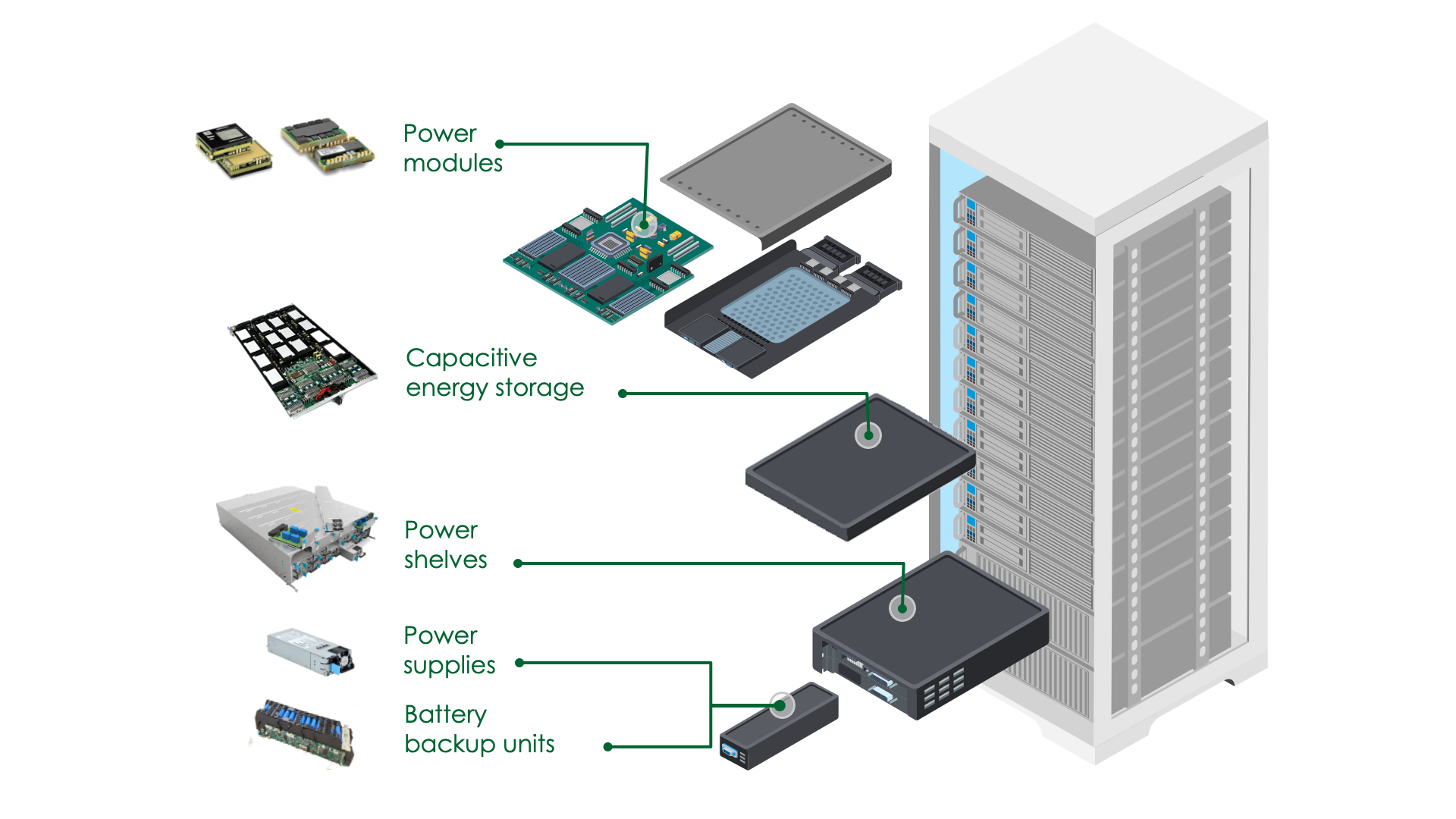
The rise of artificial intelligence (AI) and machine learning (ML) has created unprecedented power demands. Next-generation data centers face significant challenges in power management, efficiency, and reliability. Traditional power solutions often fall short at both the component level and the overall data center infrastructure management (DCIM) level. Advanced power components and integrated monitoring solutions provide a comprehensive approach to address these challenges.
Examples include hybrid capacitor technologies for stable power delivery, ultra-low equivalent series resistance (ESR) solutions to improve high-current power conversion efficiency, high-precision resistors for accurate power monitoring, and wireless integration for comprehensive power management.
This article examines how these elements contribute to robust power management systems for AI-driven data centers. It then describes Panasonic solutions across these four areas and demonstrates their application in modern data center environments.
Using Hybrid Capacitor Technology for Efficient Power Delivery
Modern data centers require extensive power conversion, often drawing high-voltage AC from the utility. That voltage is stepped down to lower AC levels distributed across the campus, then converted to hundreds of volts AC for rack distribution.
At the rack level, AC is converted to DC, commonly to 12 VDC to supply IT equipment. Inside each device, voltages are further regulated down to lower rails, typically between 1.1 V and 5 V, to power processors and memory modules.
Each stage in the power chain incurs losses that affect overall data center efficiency. Designers increasingly adopt wide-bandgap (WBG) semiconductors such as gallium nitride (GaN) to reduce losses in subsequent conversion stages. Compared with silicon devices, WBG devices enable higher switching frequencies and lower conduction losses, improving efficiency.
However, the capacitor technologies used in these converters present design challenges. Designers traditionally choose between aluminum electrolytic capacitors, which offer low leakage, and polymer capacitors, which provide excellent ESR characteristics. Panasonic's EEH series hybrid aluminum electrolytic capacitors (Figure 1) offer a third option by combining the advantages of both types, minimizing losses from leakage and ESR.
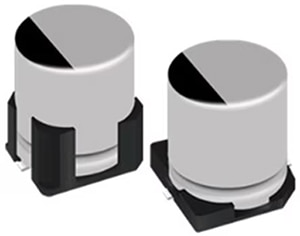
Other benefits of hybrid capacitors include improved reliability through open-circuit failure modes and the ability to retain rated capacitance at frequencies far above those of conventional designs. Conventional capacitors begin to lose effectiveness at tens of kilohertz, while hybrid capacitors maintain performance approaching 1 MHz. Such high operating frequencies enable smaller capacitor form factors, allowing designers to create more compact converters or free PCB space for additional functionality.
An example hybrid device is the EEH-ZA1V151P. This 150 μF, 35 V component has an ESR as low as 27 mΩ, an operating temperature range from -55°C to about +105°C, and a rated life of 10,000 hours at +105°C. STMicroelectronics' EVLMG1-250WLLC DC/DC converter evaluation board (Figure 2) demonstrates the suitability of this device for data center applications. That GaN board achieves a power density of 20 W/in.3 and efficiency above 92%.
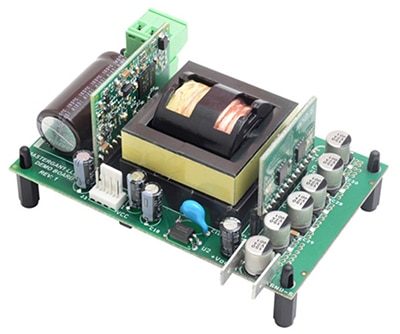
Advantages of Low-ESR Capacitors for High-Density, High-Efficiency Power Delivery
High-power-density DC/DC converters are becoming common in data centers, which introduces thermal management challenges. Increased power density and reduced component area raise operating temperatures significantly.
Reducing capacitor ESR helps mitigate thermal challenges because power loss follows the I2R relationship; lowering resistance directly reduces dissipation and heat generation. Therefore, low ESR is critical to maintaining safe operating temperatures in compact designs.
Even the most efficient capacitors will experience elevated temperatures in real-world operation. For component-dense data centers, selecting capacitors that tolerate high temperatures is essential. Figure 3 shows a selection chart that accounts for operating temperature and other factors.
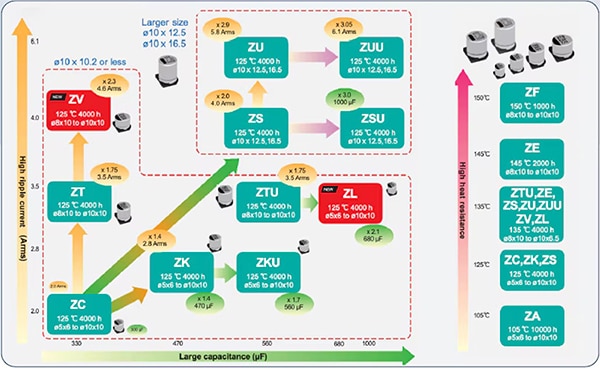
Although GaN's high switching frequency enables smaller enclosures, capacitor technology must still provide sufficient capacitance to handle high ripple currents. The EEH-ZL series hybrid capacitors cover capacitances from 47 μF to 680 μF and can handle up to 2.3 A ripple current at 100 kHz, addressing these requirements. These devices are specified for operation up to +135°C with ESR as low as 14 mΩ.
For example, the EEH-ZL1E681P is a 680 μF capacitor with 14 mΩ ESR and a 10.0 mm case diameter.
Precise Power Monitoring with High-Precision Resistors
DC/DC converters in data center applications require highly accurate power control feedback. This is especially important in GaN-based designs, where small feedback errors in duty cycle can lead to dangerous over-voltage or over-current conditions.
While various current-sensing techniques exist, shunt resistors remain attractive for space-constrained environments such as servers, storage systems, and power supplies. However, high power density in modern designs poses challenges for resistor-based current sensing.
The primary challenge is thermal stability. Resistance can shift significantly with temperature changes, affecting measurement accuracy. Therefore, a low temperature coefficient of resistance (TCR) is a key parameter; minimizing TCR is necessary to maintain measurement accuracy across the wide temperature ranges encountered in data center operation.
Panasonic's ERA-8P series resistors (Figure 4) address these challenges through several innovations:
- Precision thin-film processing achieves ultra-low TCR of ±15 × 10^-6^ per kelvin.
- A soft resin layer under the resistor reduces stress and minimizes solder-induced cracking during thermal cycling.
- A smooth alumina substrate surface ensures uniform resistor film thickness.
- An elongated, meandering resistor pattern distributes current density and delivers industry-leading ESD performance.

The ERA-8PEB1004V demonstrates these features and is well suited to data center power monitoring:
- High withstand voltage, up to 500 V at 1 MΩ, suitable for monitoring high-voltage rails.
- Rated power of 0.25 W to minimize power dissipation.
- Operating temperature range from -55°C to +155°C.
- Robust ESD capability for reliable operation in high-power environments.
Monitoring Energy Efficiency via Wi-Fi
As AI workloads drive the deployment of more servers, storage systems, and power equipment, DCIM complexity increases. Monitoring power consumption is essential for optimizing efficiency, but wired monitoring can add cost and complexity and worsen cable management as facilities scale.
Wireless monitoring offers a simpler alternative by providing real-time power management through voltage, current, and temperature measurements without additional wiring. This approach is flexible and allows scaling without reconfiguring physical connections.
Wireless modules for data center applications must meet strict requirements:
- Maintain reliable connections in environments with many obstacles and potential interference sources.
- Minimize power consumption to preserve overall efficiency gains.
- Be compact for integration with existing equipment.
- Include strong security features to protect sensitive data center information.
Panasonic's ENW-49A01A3EF PAN9320 Wi-Fi module (Figure 5) addresses these needs:
- Operates at 2.4 GHz to penetrate obstacles common in data centers and supports 802.11b/g/n for broad compatibility.
- Low power consumption: in 802.11b mode, transmit (Tx) current is 430 mA minimum and receive (Rx) current is 160 mA, supporting energy-efficient operation.
- Compact surface-mount package of 29.0 mm × 13.5 mm × 2.66 mm for simplified integration.
- Built-in security features such as TLS/SSL, HTTPS, and WPA2 to protect sensitive information.
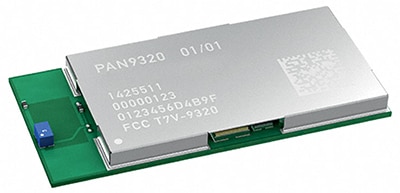
Conclusion
AI workloads require a reassessment of power infrastructure, from component selection to facility-wide monitoring systems. Hybrid capacitors, ultra-low ESR technologies, precision resistors, and wireless connectivity form a set of technical options that help data center operators build and maintain efficient, scalable power systems to support next-generation AI applications.
 ALLPCB
ALLPCB




